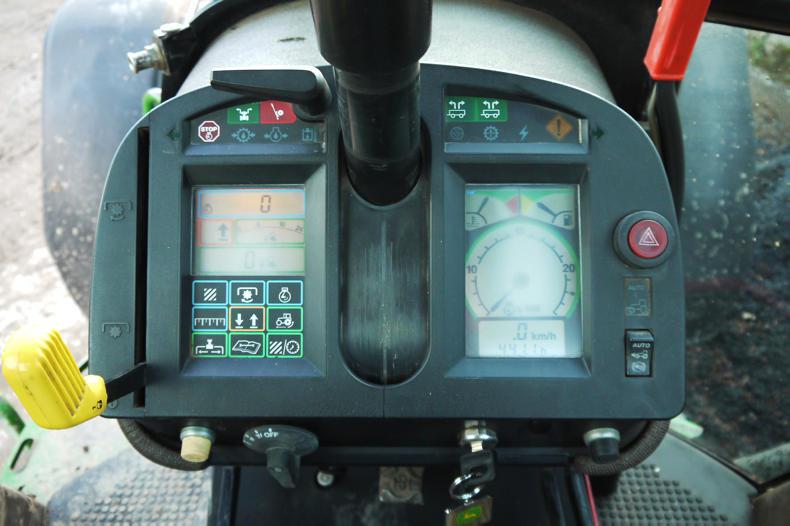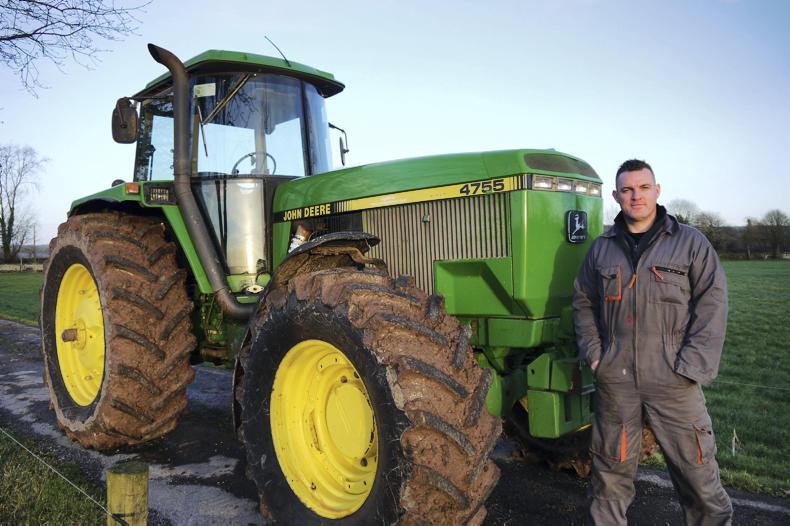When John Cashman went to work on a tillage farm in Cambridge in 1999, he had the enviable job of driving a 190hp John Deere 4755 fitted with both front and rear dual wheels. This was used for secondary cultivation work following a John Deere 8400 ploughing. The tractor held such strong memories with John that when a very clean one came up for sale in the UK at the end of 2017 he bought it.
History
Originally introduced in Palm Springs, California in 1989 and SIMA, Paris the same year, the Waterloo-built 55 series consisted of five models from 128-228hp. They were considered by many to be an updated and improved version of the previous 50 series.
The top two models – the 4755 and 4955 – had a longer wheelbase. Power for all models was from a 7.6l engine with redesigned valves and ports boosting airflow by 20%.
The turbochargers were larger and the top two models were fitted with after-coolers. Intellitrak electronic monitoring system was a new feature. LCD screens on both sides of the steering wheel displaying engine RPM, actual forward speed if a radar was fitted, wheel-slip and PTO speed. This was considered the beginning of the electronic era.

Lift capacity of the smaller three models was 6.4t with the 4755 and 4955 able to lift 8.4t. The rear-linkage was managed by John Deere’s Prohytronic electronic sensing and lift control system. This included three dials controlling drop rate, lift height limit and position or draft control mix.
An exterior mudguard-mounted toggle-switch for raising and lowering the lift arms from the ground was fitted. This was uncommon for a tractor of this era as most tractors built at the time had mechanical lift control so this was really revolutionary.
Deere desire
Such was John’s keenness to see this tractor he drove almost seven hours from Pembrooke in southwest Wales to the dealer selling it – G.M. Stephensons in Scarborough, Yorkshire – to make sure he didn’t miss his chance of owning this tractor. I met with John to get the history and story behind his tractor.
“It’s a 1994 model with approximately 10,000 hours on the clock. It was one of the last of this range of tractor produced as it has all the upgrades that were made before production ceased”.
These upgrades included the side-mounted exhaust which was introduced in 1991 as opposed to being in the middle of the bonnet which greatly improved visibility forwards. The air-intake also migrated out of sight to the front of the bonnet making the view forwards a lot clearer.
“The upgraded cab steps make cab access a lot easier compared to the previous ‘ladder’ design.”
Approaching the tractor, the steps are almost welcoming you into the cab as they are angled out from the tractor at 45 degrees with a handrail on both sides.
“I knew when I sat into the tractor it was straight and original. The paint is slightly faded which proved to me it was genuine but more importantly the cab was spotlessly clean. The materials John Deere used in this generation stood the test of time.”
Keen to experience this Waterloo wonder, I took the tractor for a drive. After navigating past the telescopic steering wheel in the compact SG2 cab and sitting into the broad comfortable seat I could immediately see what John meant. The tractor, and especially the interior, were really well looked after with little sign of wear apart from the shiny lever tops. Looking out the side window the engine panels and surrounding steel work showed no sign of corrosion. The front mudguards had characteristically shrunk which was an issue with them at the time.
“I think this is due to the material that was used in the plastic. It shows the age of the tractor and how original it is. I’ll probably change them in time but otherwise I’ll keep it as I bought it.”
I asked John if he knew what the tractor was doing before he acquired it.
“I know the previous owner bought it in 1999 for use on a tillage farm in Yorkshire. In the summertime it was operating a big square baler. For the autumn and winter it was used for some heavy cultivations.

Proud owner John Cashman with his very clean John Deere 4755.
“In the latter years of its life it on the farm it was used for secondary cultivations hence the dual wheel attachment points on all wheels. In my experience of driving a tractor identical to this, having dual wheels fitted all around meant ground compaction was minimised and traction was super as the tractor had the weight to get the power to the ground. Sitting behind the wheel of this tractor and driving it was a real pleasure.
The engine purred at low revs and had plenty of bark when the throttle was pressed. The 15-speed powershift transmission changed very smoothly with each one definite yet subtle. I asked John what plans he had for the tractor.
“We will use it here on the farm for ploughing, discing and slurry spreading. It’s a working tractor and it needs to keep working. Apart from that I will use it in a few local tractor runs and working demonstrations”.
No doubt it will turn a few heads again just like it would have done when it was first launched to the market in 1989.
Special thanks to Chris Lockwood from Anglian Agri Media Ltd.






 This is a subscriber-only article
This is a subscriber-only article



























SHARING OPTIONS: